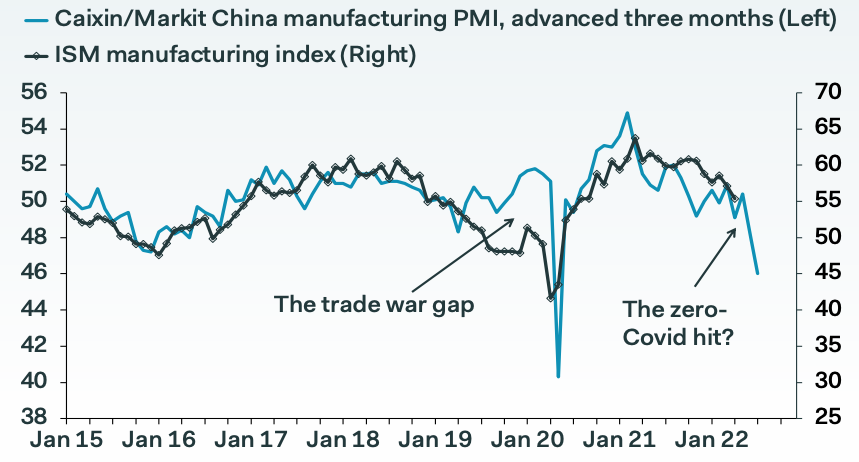- China's recent COVID lockdown has led to a slowdown in manufacturing-industry growth.
- That's a bad omen for US manufacturing, which is closely linked to China's on a lagging basis.
- Still, the US is likely to fare better than China thanks to its shale business and reliance on other industries.
China's latest COVID lockdown has produced a domino effect that might topple onto the US economy next.
That's because China is seeing a major manufacturing slowdown as the nation closes shop. The fate of US manufacturing is inextricably linked to China's, the former of which is typically three months behind the latter, according to Pantheon Economics, a macroeconomic research firm.
The chart below shows just how closely manufacturing activity in the two nations has been linked over the past several years. The diving light-blue line does not suggest bright times ahead for the US.

In fact, the Institute for Supply Management (ISM) index — a monthly metric of the US economy based on a survey of purchasing managers at more than 300 manufacturing firms — has already been slowing down over the past few months. It fell for a second straight month in April, to 55.4, marking its fifth decline in the last six periods.
"It's hard to imagine that U.S. manufacturing overall can strengthen against such a difficult backdrop from China," the Pantheon researchers wrote. "The prospects for manufacturing are dimming, thanks to the chaos triggered by China's zero-COVID policy."
A slowdown in the manufacturing industry risks rippling into adjacent industries and impacting parts of the US where factories employ large portions of population.
Meanwhile, in China, the nation's main manufacturing index fell further below 50 in April, marking a second straight contraction. The 50 level is considered the threshold for whether manfacturing is growing or shrinking.
It's the second month in a row China's manufacturing and non-manufacturing indices dropped simultaneously. Before March, the last time both dipped below that mark together was February 2020, when China first worked to stop the spread of the coronavirus.
A manufacturing slowdown doesn't mean doom for the US recovery
Despite it's bearishness on manufacturing, Pantheon notes that it only accounts for roughly 11% of US gross domestic product (GDP), compared to 26% in China. The US manufacturing sector has actually slipped into recession — typically defined as at least two consecutive quarters of contraction — on multiple occasions over the past decade, while headline GDP has stayed strong.
Pantheon also points out that the US shale industry — which has a big impact on ISM manufacturing readings — has been strong and will continue to outperform as oil prices keep rising.
Only a few components of the core Consumer Price Index are "very sensitive" to developments in China, the researchers wrote, including: clothing, household electronics, appliances, and furniture.
"The domestic labor market and the state of the vehicle market matter much more," Pantheon concluded.
